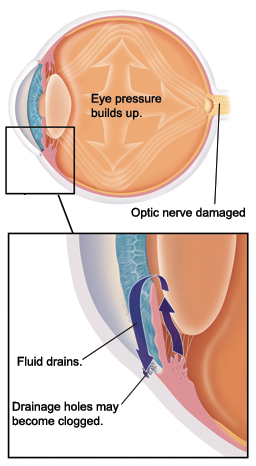A
B
C
D
E
F
G
H
I
J
K
L
M
N
O
P
Q
R
S
T
U
V
W
X
Y
Z
Topic IndexLibrary Index
Click a letter to see a list of conditions beginning with that letter.
Click 'Topic Index' to return to the index for the current topic.
Click 'Library Index' to return to the listing of all topics.
What Is Glaucoma?
Glaucoma is an eye disease that can cause blindness. If found early, it can often be controlled. But it often causes no symptoms, so you need regular eye exams to find it. Glaucoma often begins when pressure builds up in the eye. This pressure can damage the optic nerve. The optic nerve sends messages to the brain so you can see. There are 2 main kinds of glaucoma: open-angle and closed-angle.

Drainage area
The eye is always making fluid. The eye's drainage areas may become clogged or blocked. Too much fluid stays in the eye. This increases eye pressure.
Optic nerve
Too much pressure in the eye can damage the optic nerve. If damaged, this nerve cannot send the messages to the brain that let you see.
Open-angle glaucoma
Open-angle glaucoma is the most common kind. It happens slowly as people age. The drainage area in the eye becomes clogged. Not enough fluid drains from the eye, so pressure slowly builds up. This causes a slow loss of side (peripheral) vision. You may not even notice changes until much of your vision is lost.
Closed-angle glaucoma
Closed-angle glaucoma is less common than open-angle. It often comes on quickly. The drainage area in the eye suddenly becomes blocked. Eye pressure builds rapidly. You may notice blurred vision and rainbow halos around lights. You may also have headaches, nausea, vomiting, and severe pain. If it is not treated right away, blindness can happen quickly.
Online Medical Reviewer:
Chris Haupert MD
Online Medical Reviewer:
Tara Novick BSN MSN
Online Medical Reviewer:
Whitney Seltman MD
Date Last Reviewed:
12/1/2022
© 2000-2025 The StayWell Company, LLC. All rights reserved. This information is not intended as a substitute for professional medical care. Always follow your healthcare professional's instructions.